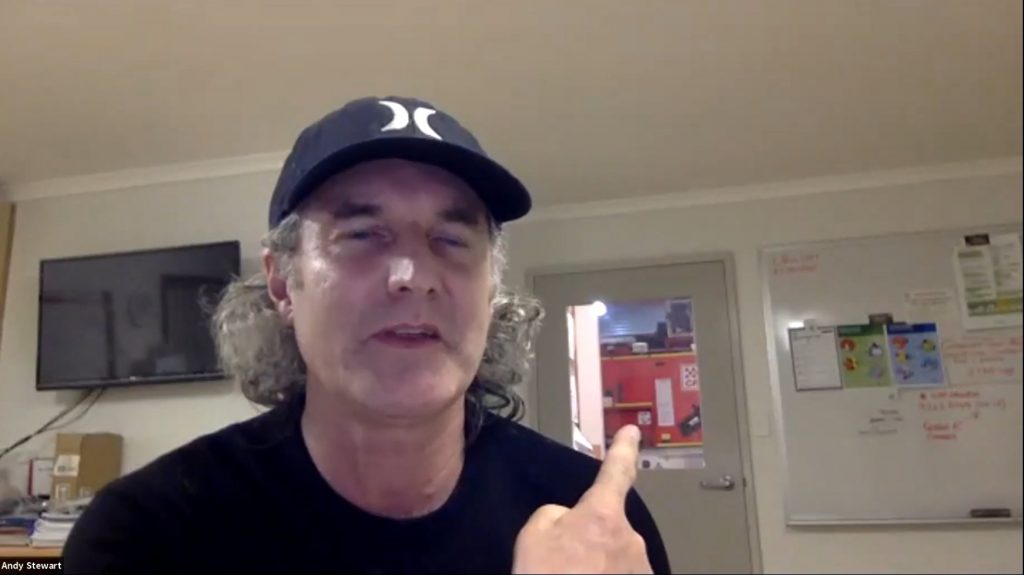On Monday September 14th, Twenty-five members and visitors joined the Melbourne Section of the AES in a Zoom call for our regular bi-monthly meeting.
The evening started with the Section’s AGM, which is reported separately here.
Following the AGM, re-elected Chairman Graeme Huon introduced Andy Stewart from The Mill Studio on Victoria’s rural Bass Coast to talk on the topic of recording in a pandemic.
Andy explained that he was calling in from the local Country Fire Authority (CFA) station, where he was taking advantage of their better Internet speed, as well as it being a quiet spot away from his young family. He is a Lieutenant in the local Brigade.

He started his talk by describing his experiences in putting together a geographically isolated choir of 100 experienced and well-known performers for the new single We Sing from the indigenous performer Kutcha Edwards.
Names like Paul Kelly, Archie Roach and Judith Durham were mentioned along with many others music industry stalwarts.
Andy acted as both Producer and Engineer, and he described how, early in the project he decided he wanted to use a choir, and planned to book the ABC’s Iwaki Auditorium in Melbourne for the project – but the entire ABC site went into lockdown just as he was preparing to make the booking, so an alternative was needed.
He recounted how he solicited contributions for many of the industry’s foremost performers, by sending them a guide track and asking them to sing to that, recording onto their own equipment, and he would assemble all the recordings into the finished product.
He described the challenges of sourcing contributions from a diverse group of performers with a wide range of technical skills and available kit. He recounted in some detail the challenges of getting a useful recording from performance legend Judith Durham in the face of her poor health and severely limited technological understanding.
Member Fabio Marraccini asked whether Andy had considered using remote musical collaboration tools, such as Audio Movers or ConnectionOpen. Andy’s response was that he had avoided that level of technology because of the great variation of equipment available to the singers, as well as the range of their technical sophistication. He commented that he made it deliberately simple at the recording end so as not to exclude anyone who was willing to participate.
Then member John Smyth chimed into the conversation by recounting his experiences with “iso” broadcasting in Community Radio, dealing with the varied home setups and technological capabilities of the presenters, demonstrating the challenges at the other end of the chain.
Andy moved on to discuss the issues of the home recording environment, and the not well-understood principle that with a typical directional mic most of the ambience that makes it on to the track is coming from behind the singer. He described that in some of the more desperate cases he had people recording with their back to an open closet or wardrobe, using the contents for absorption or diffusion.
The We Sing video was then played into the Zoom session to give the audience a feel for the scope of the project, displaying the range of singers involved and the high standard of the finished product. The video also gave some interesting views of Andy’s studio.
This video can be viewed on YouTube at
https://www.youtube.com/watch?v=zxVF7zUD9S0
In response to questions about the project time frame, Andy indicated that the single had taken a couple of months to complete, and barring unforeseen circumstances the album should be completed by the end of the year.
A question was then asked about the use of plugins vs outboard hardware as effects units. He said he used a mixture of both, but found the ability to recall settings in the digital realm as being critical in many cases.
He commented that the choir was, in the end, relatively unprocessed. Each contribution was dealt with as it came in with minor compression, de-essing and high-pass filtering. No buss-processing was employed.
Asked about the challenges of synchronization, and time slippage he commented that he did a lot of quick cutting to time-sync, but mainly to fix performer timing rather than time-sync issues
Andy described the range of approaches of various singers, and remarked that something of this scope could never have come together except remotely, given how widely dispersed the singers were, and also the difficulty in producing and conducting such a diverse group in a single space and time.
A discussion on the choice of preamps followed. Andy commented that the preamps on his Neve desk were his first choice, but that he also had some Telefunken and Quad Eight units that he used from time to time, commenting that it often depended on the mic he chose to use, as to how well it worked with a particular preamp.
Member Chris Ludowyk commented that he had been involved in a similar project with the jazz group he plays in, The Syncopators, and indicated that he would welcome comments on that work which is available on their YouTube channel at
https://www.youtube.com/channel/UCth4-rJISlFOwWji0cVDjSg/videos
Ironically, just as the questions (and Andy) were winding down the CFA fire alarm sounded, summoning Andy to the fire station to attend a call-out, so Graeme quickly thanked Andy for a most interesting presentation, and we let Andy grab his hard-hat and head off to kit up for his CFA duties.
We thank Andy for his generosity with his time, and in sharing his techniques.
An edited version of the Zoom video is below:
This video is also available on our YouTube channel at: https://www.youtube.com/watch?v=mun-0qCTOng
The Mill Studio website is at: http://themillstudio.com.au
The official video of the Kutcha Edwards song “We Sing” is on YouTube at:
https://www.youtube.com/watch?v=zxVF7zUD9S0
Kutcha Edwards website is https://www.kutcha-edwards.com/


